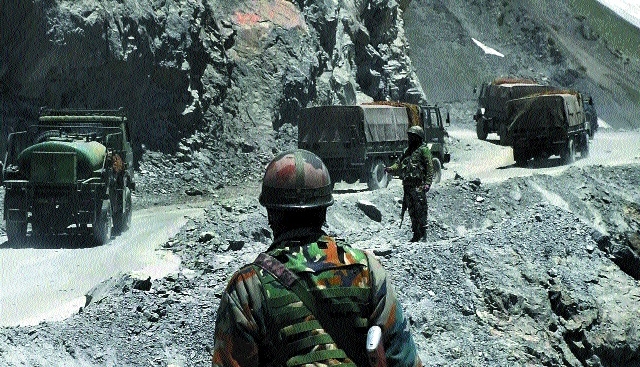Chinese troops move back from Patrolling Pts 14, 15 in Galwan
| Date :09-Jul-2020 |

Ever strong in resolve to keep the enemy at bay, soldiers stand guard upon the movement of an Army convoy. (ANI)
NEW DELHI :
There has been thinning out of troops from Finger areas in Pangong Tso. The Chinese also removed all temporary structures and completed withdrawal of troops from Hot Springs. The two armies are expected to carry out a joint verification in the next few days, sources said.
THE disengagement process in Ladakh was completed on Wednesday as Chinese troops moved fully away from Patrolling Point 14 and 15 to a location 2 kilometres away from the Line of Actual Control (LAC), Indian Army sources said. The disengagement started after a two-month military stand-off and it is happening “as per agreed terms in the Corps Commanders’ meeting”. After the disengagement process is completed, the two Armies are likely to hold further talks to take the process further. Sources said, Chinese soldiers have removed tents and structures at Patrolling Point 14 and Patrolling Point 15 in Galwan Valley.
On June 15, Indian and Chinese People’s Liberation Army soldiers were engaged in brutal hand-to-hand combat at Patrolling Point 14. A total 20 Indian soldiers and 43 Chinese troops were killed in the worst clash in four decades. As per the agreement between the Corps Commanders, a buffer zone of at least 1.5 km on both sides of the Line of Actual Control has to be created in these areas. Sources said that in Galwan Valley, the water level of the Galwan river has risen suddenly due to melting of snow, which could have forced the Chinese to move from the area faster.
The Indian Army is reported to be using drones to verify Chinese movement as physical verification has been hindered by rising levels of Galwan river. At Pangong lake, the most contentious issue between the two sides, Chinese troops have moved up to Finger 4 where they have brought over 120 vehicles and dozen boats. The Chinese Army has also opened up a new front in the area near the Depsang Bulge, a table-top plateau north of Galwan. They have built camps and deployed vehicles and troops. The Pangong lake is divided into 8 Fingers. The mountainous spurs jutting out into the lake are referred to as Fingers. India has been claiming Fingers 1 to 8. There is also an Indian post near Finger 4.
India claims the entire stretch till Finger 8. The area between Finger 5 and 8 has been a matter of dispute as China claims it. It has often witnessed confrontations. China has made an attempt to change the status quo by putting up shelters and setting up camps in areas that were under Indian control so far. The military commanders from both sides are in constant touch with each other. However, India remains cautious and the Army and Air Force are on high alert.
Special Representatives of India and China on the Boundary Question -- National Security Advisor Ajit Doval and Chinese State Councillor and Minister of Foreign Affairs Wang Yi -- had a “frank and in-depth exchange” telephone conversation on Sunday during which they agreed that both sides should complete the ongoing disengagement process along the LAC expeditiously, according to a statement by Ministry of External Affairs released on Monday. They said that both sides should strictly respect and observe the LAC and should not take any unilateral action to change the status quo.